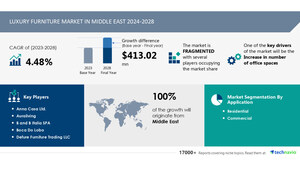NEW YORK, April 1, 2024 /PRNewswire/ -- The maritime information market size is set for significant growth between 2023 and 2027. According to forecasts, the market is anticipated to surge by USD 1.02 billion, marking a noteworthy Compound Annual Growth Rate (CAGR) of 9.97%. Several factors are driving this surge, including the imperative need for regulatory compliance, the quest for operational efficiency, and the integration of Automatic Identification System (AIS) technologies into maritime solutions.
For more insights on the historic period (2017 to 2021), and forecast market size (2023 to 2027) - Request a sample report
Commercial Segment Spearheads Growth:
One of the pivotal growth drivers is the commercial segment, which encompasses a spectrum of industries such as port management, commercial shipping, hydrographic and charting services, business intelligence, commercial fishing, and offshore commercial activities. This segment has exhibited a steady ascent in market share, reflecting the industry's increasing inclination towards adopting advanced solutions to safeguard maritime resources and enhance operational efficiencies.
Regulatory Compliance and Security Drive Market Momentum:
The stringent regulatory landscape governing maritime operations has spurred the demand for cybersecurity solutions aimed at protecting critical data from cyber threats. Initiatives like Inmarsat's Fleet Secure, designed to fortify fleets against cyberattacks, underscore the industry's proactive stance towards cybersecurity. Additionally, regulations set forth by entities such as the European Union Agency for Network and Information Security (ENISA) are expected to catalyze market growth by prioritizing safety and security in maritime activities.
Seaborne Trade Expansion Fuels Market Opportunities:
The global push towards expanding seaborne trade, epitomized by initiatives like the Panama Canal and the One Belt-One Road project, presents abundant opportunities for market players. The resultant increase in vessel traffic necessitates robust maritime information solutions to manage the burgeoning demands of the shipping network. Furthermore, the advent of the Fourth Industrial Revolution amplifies these opportunities, offering new avenues for maritime transport and trade activities.
For more insights on the market - Request a sample report
Overcoming Implementation Challenges:
Despite the promising growth trajectory, the market faces challenges, notably the high cost of implementation. The deployment of solutions incurs expenses related to software licensing, customization, maintenance, and training, posing a barrier to widespread adoption. Moreover, the need for skilled IT professionals to manage these solutions further escalates costs, hindering market expansion.
Navigating the Competitive Landscape:
Key players in the Maritime Information Market are deploying various strategies such as strategic alliances, mergers, acquisitions, and product/service launches to fortify their market presence. Companies like BAE Systems Plc, Inmarsat Global Ltd., and Lockheed Martin Corp. are at the forefront, leveraging innovation and collaboration to drive industry advancements.
Regional Insights:
Europe emerges as a pivotal region, accounting for a substantial share of the global market growth. Initiatives such as the European Maritime Safety Agency's SafeSeaNet system exemplify the region's commitment to maritime safety and operational efficiency, fostering a conducive environment for market expansion.
To learn more about this report - Request a sample report
Conclusion:
In conclusion, the Maritime Information Market is poised for robust growth driven by regulatory imperatives, expansion of seaborne trade, and technological advancements. Despite implementation challenges, the industry's resilience and innovation herald a promising future, characterized by enhanced safety, efficiency, and sustainability in maritime operations.
Analyst Review
The Maritime Information Market is undergoing a transformative phase driven by a convergence of technological advancements, regulatory imperatives, and sustainability goals. In an era where environmental protection, efficient shipping operations, and real-time data accessibility are paramount, governing agencies, maritime stakeholders, and industry players are increasingly turning to innovative solutions to navigate the complexities of the maritime sector.
Key to this transformation is the integration of Internet of Things (IoT) sensors, satellite communication systems, and advanced artificial intelligence (AI) and machine learning (ML) algorithms. These technologies empower fleet management with unprecedented levels of data analytics and predictive maintenance capabilities, enabling proactive decision-making and optimized operations while mitigating risks associated with offshore energy exploration, navigation, weather forecasting, and cargo tracking.
Furthermore, environmental monitoring is at the forefront, with a heightened focus on combating cybersecurity threats and addressing data privacy concerns. Advanced maritime information systems leverage big data analytics to enhance supply chain efficiency, meet sustainability goals, and drive digitalization and automation across the industry.
Consolidation and strategic partnerships are becoming increasingly common as companies seek to bolster their capabilities and offerings in line with eco-friendly solutions and regulatory requirements. However, challenges persist, ranging from maritime accidents and piracy incidents to environmental disasters, underscoring the need for robust security measures and stringent regulations.
In this landscape, insights gleaned from maritime safety, security, and regulations play a pivotal role in shaping the industry's trajectory. Furthermore, advancements in port management, particularly in regions like Europe and North America, are driving acquisitions and fostering collaboration to strengthen the resilience and efficiency of maritime operations.
Amidst these dynamics, the Maritime Information Market serves as a critical nexus, providing actionable intelligence and facilitating informed decision-making across the shipping industry and international trade networks. By harnessing the power of data-driven insights, fisheries management, port operations, and maritime security are poised to undergo significant transformations.
Ultimately, the future of the Maritime Information Market lies in its ability to adapt and innovate in the face of evolving challenges and opportunities. By embracing sustainability principles, harnessing technological advancements, and fostering collaboration, the industry can navigate towards a more secure, efficient, and environmentally conscious future.
Get a glance of this market - Request a sample report
Market Overview
The Maritime Information Market is a dynamic ecosystem where environmental protection, shipping operations, and fleet management converge. Governing agencies rely on real-time data from IoT sensors and satellite communication systems to monitor vessel activities. Artificial intelligence and machine learning algorithms analyze this data for insights, enabling predictive maintenance capabilities and optimizing offshore energy operations. With advanced data analytics, the maritime sector enhances navigation accuracy and weather forecasting, improving safety and efficiency. This market thrives on innovation, integrating technology to mitigate environmental impact while maximizing operational performance. As the industry evolves, the demand for comprehensive maritime information solutions continues to grow, driving the development of cutting-edge technologies and fostering sustainable practices in the maritime domain.
For more insights on the market - Request a sample report
Related Reports:
The Maritime Surveillance Market size is estimated to grow by USD 1,476.9 million between 2022 and 2027 accelerating at a CAGR of 3.65% during the forecast period. This report extensively covers market segmentation by component (sensors, radar, AIS receiver, and software and others), end-user (defense, customs, fisheries, intelligence, and others), and geography (North America, Europe, APAC, Middle East and Africa, and South America). The growing marine threats are the key factor driving the global maritime surveillance market growth.
The maritime security market is estimated to grow at a CAGR of 3.34% between 2022 and 2027. The size of the market is forecast to increase by USD 3,702.13 million. This report extensively covers market segmentation by type (deepwater security and perimeter security), technology (surveillance and tracking, screening and scanning, communications, and other systems), and geography (North America, Europe, APAC, Middle East and Africa, and South America). The growing marine threats are notably driving the market growth.
Table of contents
1 Executive Summary
2 Landscape
3 Sizing
4 Historic Size
5 Five Forces Analysis
6 Segmentations
7 Customer Landscape
8 Geographic Landscape
9 Drivers, Challenges, and Trends
10 Vendor Landscape
11 Vendor Analysis
12 Appendix
About US
Technavio is a leading global technology research and advisory company. Their research and analysis focuses on emerging market trends and provides actionable insights to help businesses identify market opportunities and develop effective strategies to optimize their market positions. With over 500 specialized analysts, Technavio's report library consists of more than 17,000 reports and counting, covering 800 technologies, spanning across 50 countries. Their client base consists of enterprises of all sizes, including more than 100 Fortune 500 companies. This growing client base relies on Technavio's comprehensive coverage, extensive research, and actionable market insights to identify opportunities in existing and potential markets and assess their competitive positions within changing market scenarios.
Contact
Technavio Research
Jesse Maida
Media & Marketing Executive
US: +1 844 364 1100
UK: +44 203 893 3200
Email: [email protected]
Website: www.technavio.com
SOURCE Technavio

WANT YOUR COMPANY'S NEWS FEATURED ON PRNEWSWIRE.COM?
Newsrooms &
Influencers
Digital Media
Outlets
Journalists
Opted In




Share this article